Business Environment and Organizational Structures
VerifiedAdded on 2020/06/05
|15
|5282
|39
AI Summary
This assignment delves into the relationship between the business environment and organizational structures, focusing specifically on Lidl as a case study. It examines Lidl's organizational structure depicted in Illustration 1, drawing upon provided references to understand how this structure facilitates the company's operations within its industry.
Contribute Materials
Your contribution can guide someone’s learning journey. Share your
documents today.
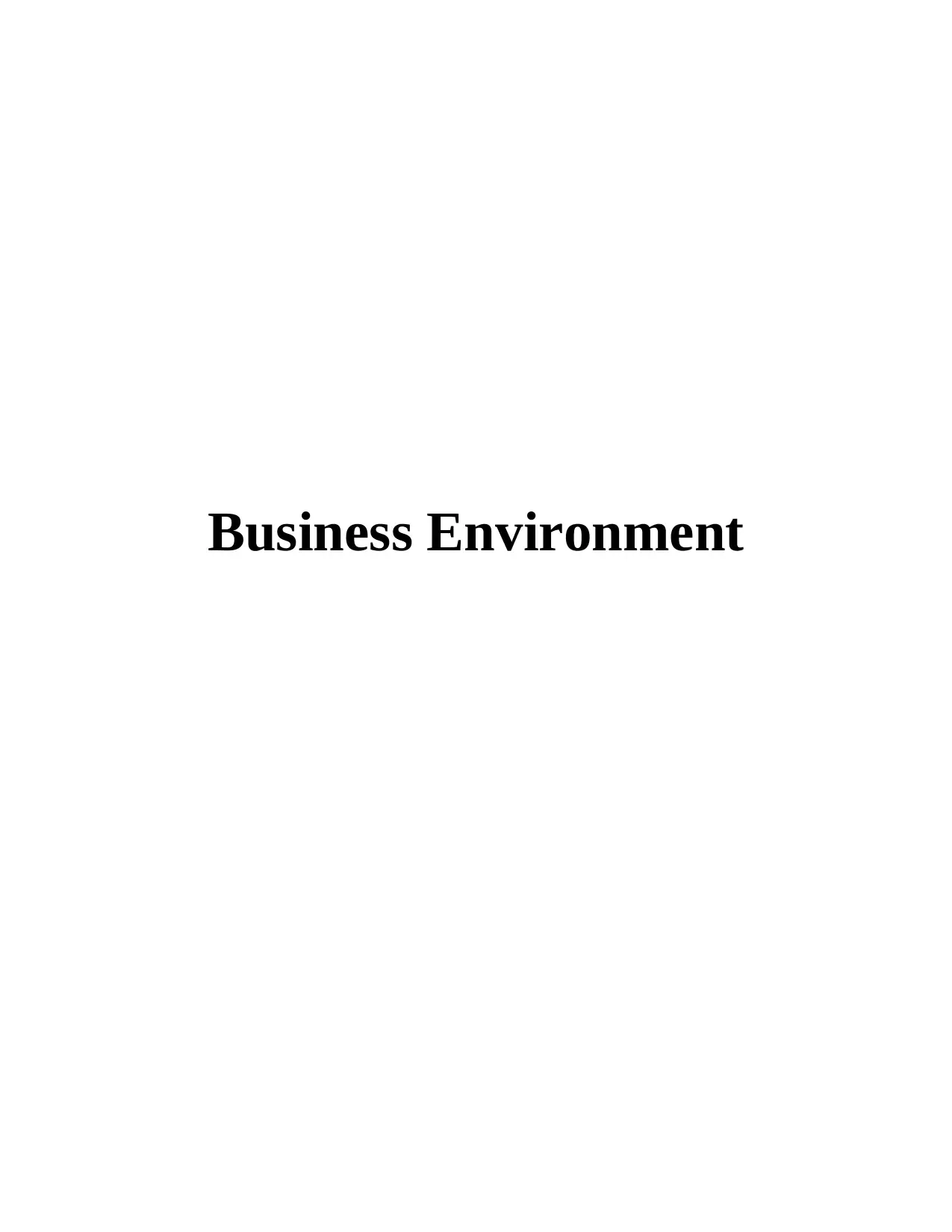
Business Environment
Secure Best Marks with AI Grader
Need help grading? Try our AI Grader for instant feedback on your assignments.
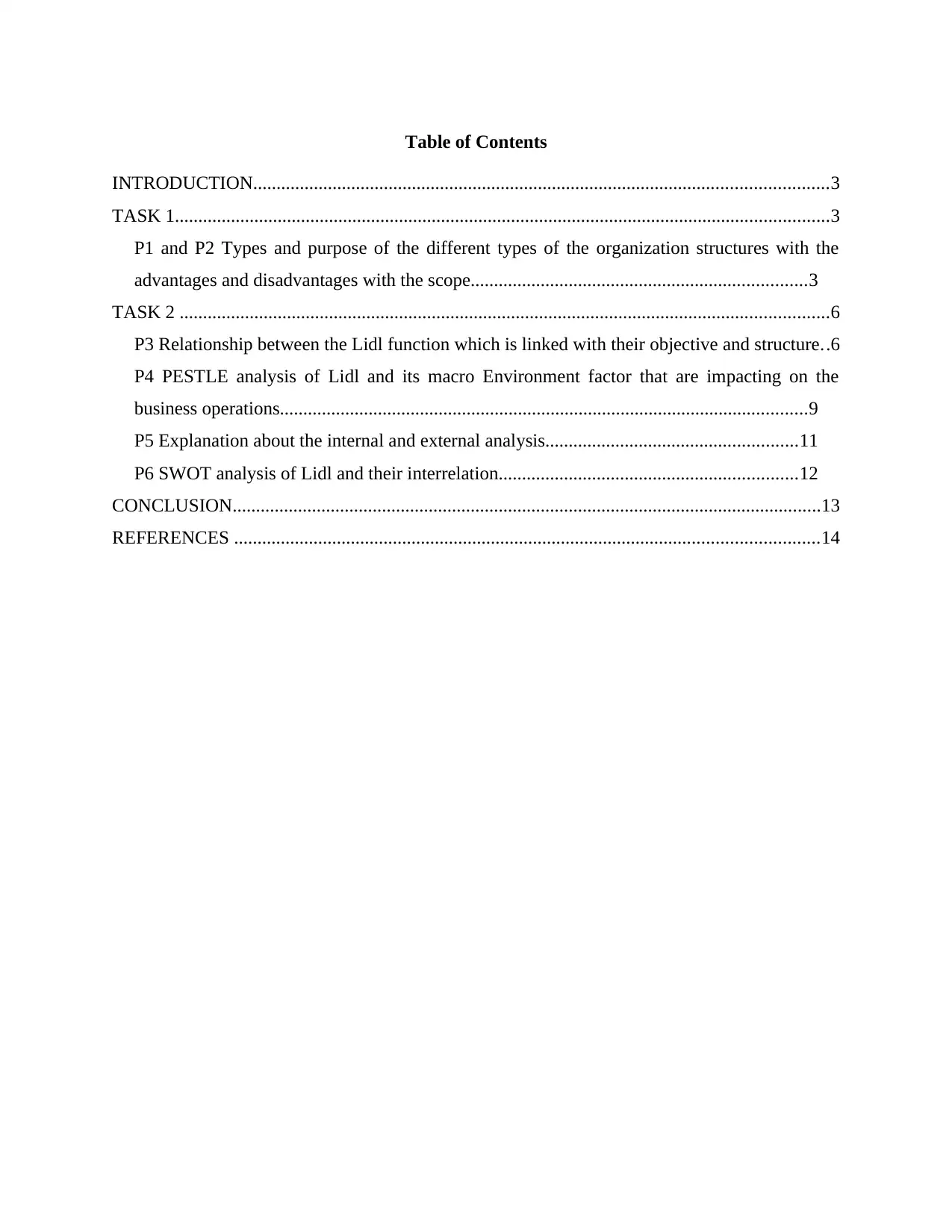
Table of Contents
INTRODUCTION...........................................................................................................................3
TASK 1............................................................................................................................................3
P1 and P2 Types and purpose of the different types of the organization structures with the
advantages and disadvantages with the scope........................................................................3
TASK 2 ...........................................................................................................................................6
P3 Relationship between the Lidl function which is linked with their objective and structure..6
P4 PESTLE analysis of Lidl and its macro Environment factor that are impacting on the
business operations.................................................................................................................9
P5 Explanation about the internal and external analysis......................................................11
P6 SWOT analysis of Lidl and their interrelation................................................................12
CONCLUSION..............................................................................................................................13
REFERENCES .............................................................................................................................14
INTRODUCTION...........................................................................................................................3
TASK 1............................................................................................................................................3
P1 and P2 Types and purpose of the different types of the organization structures with the
advantages and disadvantages with the scope........................................................................3
TASK 2 ...........................................................................................................................................6
P3 Relationship between the Lidl function which is linked with their objective and structure..6
P4 PESTLE analysis of Lidl and its macro Environment factor that are impacting on the
business operations.................................................................................................................9
P5 Explanation about the internal and external analysis......................................................11
P6 SWOT analysis of Lidl and their interrelation................................................................12
CONCLUSION..............................................................................................................................13
REFERENCES .............................................................................................................................14
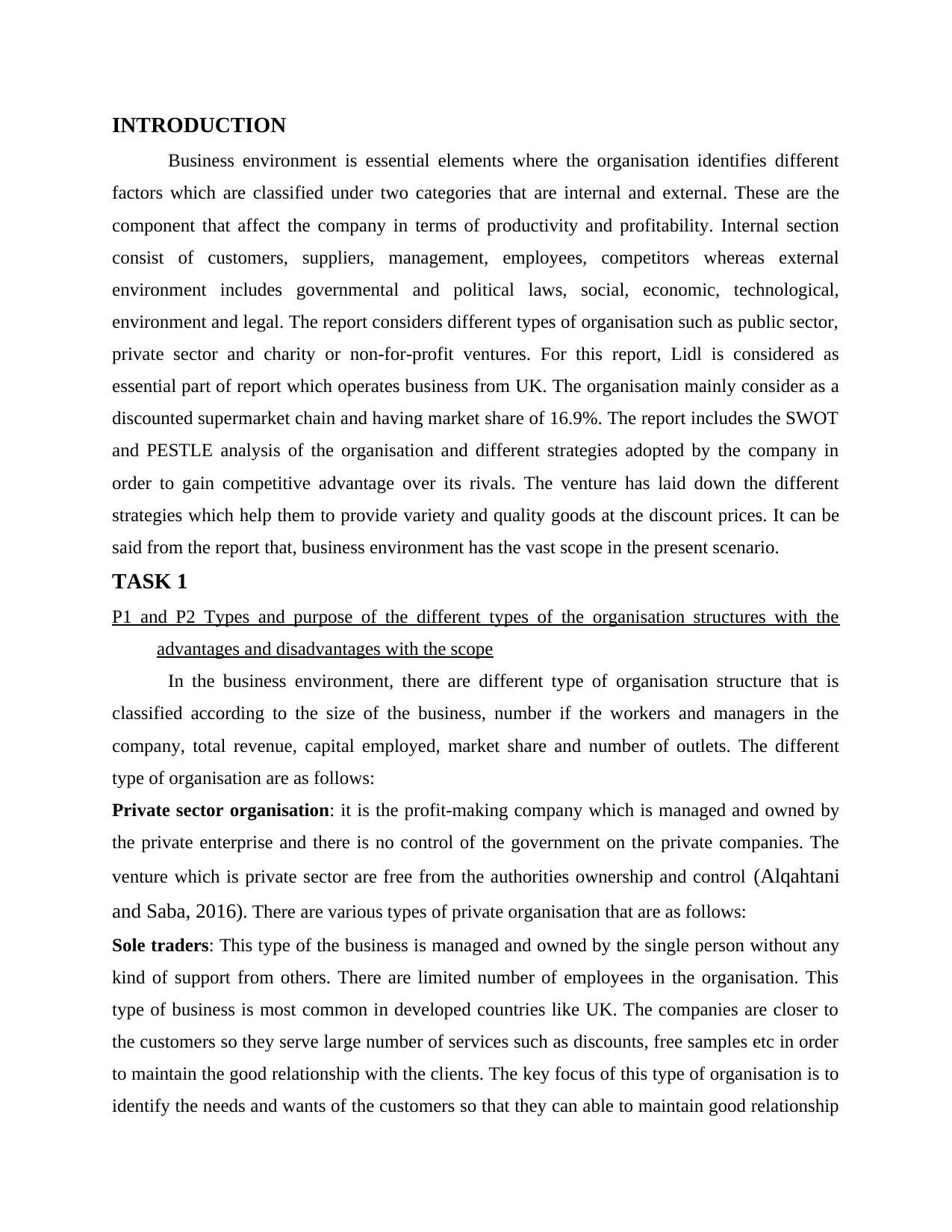
INTRODUCTION
Business environment is essential elements where the organisation identifies different
factors which are classified under two categories that are internal and external. These are the
component that affect the company in terms of productivity and profitability. Internal section
consist of customers, suppliers, management, employees, competitors whereas external
environment includes governmental and political laws, social, economic, technological,
environment and legal. The report considers different types of organisation such as public sector,
private sector and charity or non-for-profit ventures. For this report, Lidl is considered as
essential part of report which operates business from UK. The organisation mainly consider as a
discounted supermarket chain and having market share of 16.9%. The report includes the SWOT
and PESTLE analysis of the organisation and different strategies adopted by the company in
order to gain competitive advantage over its rivals. The venture has laid down the different
strategies which help them to provide variety and quality goods at the discount prices. It can be
said from the report that, business environment has the vast scope in the present scenario.
TASK 1
P1 and P2 Types and purpose of the different types of the organisation structures with the
advantages and disadvantages with the scope
In the business environment, there are different type of organisation structure that is
classified according to the size of the business, number if the workers and managers in the
company, total revenue, capital employed, market share and number of outlets. The different
type of organisation are as follows:
Private sector organisation: it is the profit-making company which is managed and owned by
the private enterprise and there is no control of the government on the private companies. The
venture which is private sector are free from the authorities ownership and control (Alqahtani
and Saba, 2016). There are various types of private organisation that are as follows:
Sole traders: This type of the business is managed and owned by the single person without any
kind of support from others. There are limited number of employees in the organisation. This
type of business is most common in developed countries like UK. The companies are closer to
the customers so they serve large number of services such as discounts, free samples etc in order
to maintain the good relationship with the clients. The key focus of this type of organisation is to
identify the needs and wants of the customers so that they can able to maintain good relationship
Business environment is essential elements where the organisation identifies different
factors which are classified under two categories that are internal and external. These are the
component that affect the company in terms of productivity and profitability. Internal section
consist of customers, suppliers, management, employees, competitors whereas external
environment includes governmental and political laws, social, economic, technological,
environment and legal. The report considers different types of organisation such as public sector,
private sector and charity or non-for-profit ventures. For this report, Lidl is considered as
essential part of report which operates business from UK. The organisation mainly consider as a
discounted supermarket chain and having market share of 16.9%. The report includes the SWOT
and PESTLE analysis of the organisation and different strategies adopted by the company in
order to gain competitive advantage over its rivals. The venture has laid down the different
strategies which help them to provide variety and quality goods at the discount prices. It can be
said from the report that, business environment has the vast scope in the present scenario.
TASK 1
P1 and P2 Types and purpose of the different types of the organisation structures with the
advantages and disadvantages with the scope
In the business environment, there are different type of organisation structure that is
classified according to the size of the business, number if the workers and managers in the
company, total revenue, capital employed, market share and number of outlets. The different
type of organisation are as follows:
Private sector organisation: it is the profit-making company which is managed and owned by
the private enterprise and there is no control of the government on the private companies. The
venture which is private sector are free from the authorities ownership and control (Alqahtani
and Saba, 2016). There are various types of private organisation that are as follows:
Sole traders: This type of the business is managed and owned by the single person without any
kind of support from others. There are limited number of employees in the organisation. This
type of business is most common in developed countries like UK. The companies are closer to
the customers so they serve large number of services such as discounts, free samples etc in order
to maintain the good relationship with the clients. The key focus of this type of organisation is to
identify the needs and wants of the customers so that they can able to maintain good relationship
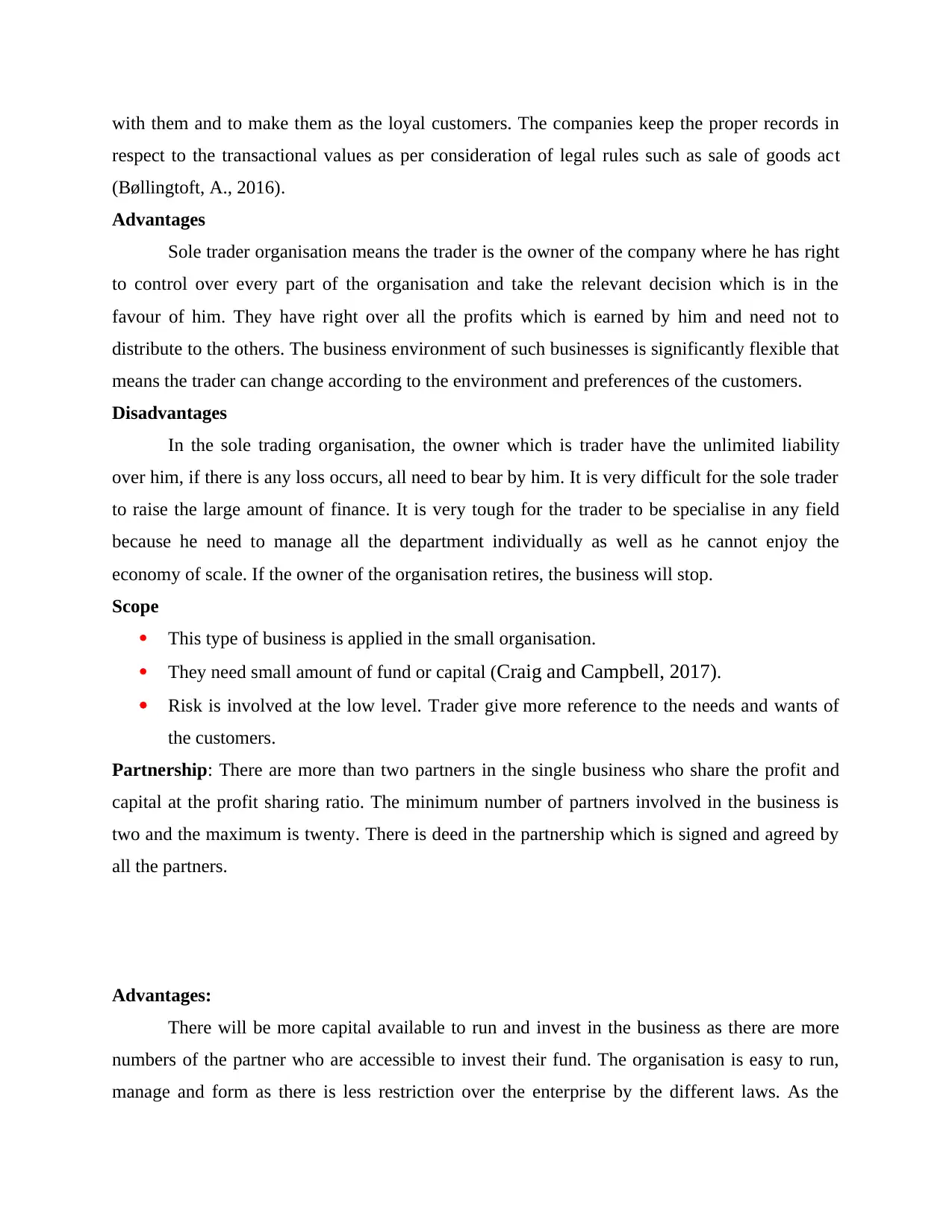
with them and to make them as the loyal customers. The companies keep the proper records in
respect to the transactional values as per consideration of legal rules such as sale of goods act
(Bøllingtoft, A., 2016).
Advantages
Sole trader organisation means the trader is the owner of the company where he has right
to control over every part of the organisation and take the relevant decision which is in the
favour of him. They have right over all the profits which is earned by him and need not to
distribute to the others. The business environment of such businesses is significantly flexible that
means the trader can change according to the environment and preferences of the customers.
Disadvantages
In the sole trading organisation, the owner which is trader have the unlimited liability
over him, if there is any loss occurs, all need to bear by him. It is very difficult for the sole trader
to raise the large amount of finance. It is very tough for the trader to be specialise in any field
because he need to manage all the department individually as well as he cannot enjoy the
economy of scale. If the owner of the organisation retires, the business will stop.
Scope
This type of business is applied in the small organisation.
They need small amount of fund or capital (Craig and Campbell, 2017).
Risk is involved at the low level. Trader give more reference to the needs and wants of
the customers.
Partnership: There are more than two partners in the single business who share the profit and
capital at the profit sharing ratio. The minimum number of partners involved in the business is
two and the maximum is twenty. There is deed in the partnership which is signed and agreed by
all the partners.
Advantages:
There will be more capital available to run and invest in the business as there are more
numbers of the partner who are accessible to invest their fund. The organisation is easy to run,
manage and form as there is less restriction over the enterprise by the different laws. As the
respect to the transactional values as per consideration of legal rules such as sale of goods act
(Bøllingtoft, A., 2016).
Advantages
Sole trader organisation means the trader is the owner of the company where he has right
to control over every part of the organisation and take the relevant decision which is in the
favour of him. They have right over all the profits which is earned by him and need not to
distribute to the others. The business environment of such businesses is significantly flexible that
means the trader can change according to the environment and preferences of the customers.
Disadvantages
In the sole trading organisation, the owner which is trader have the unlimited liability
over him, if there is any loss occurs, all need to bear by him. It is very difficult for the sole trader
to raise the large amount of finance. It is very tough for the trader to be specialise in any field
because he need to manage all the department individually as well as he cannot enjoy the
economy of scale. If the owner of the organisation retires, the business will stop.
Scope
This type of business is applied in the small organisation.
They need small amount of fund or capital (Craig and Campbell, 2017).
Risk is involved at the low level. Trader give more reference to the needs and wants of
the customers.
Partnership: There are more than two partners in the single business who share the profit and
capital at the profit sharing ratio. The minimum number of partners involved in the business is
two and the maximum is twenty. There is deed in the partnership which is signed and agreed by
all the partners.
Advantages:
There will be more capital available to run and invest in the business as there are more
numbers of the partner who are accessible to invest their fund. The organisation is easy to run,
manage and form as there is less restriction over the enterprise by the different laws. As the
Secure Best Marks with AI Grader
Need help grading? Try our AI Grader for instant feedback on your assignments.
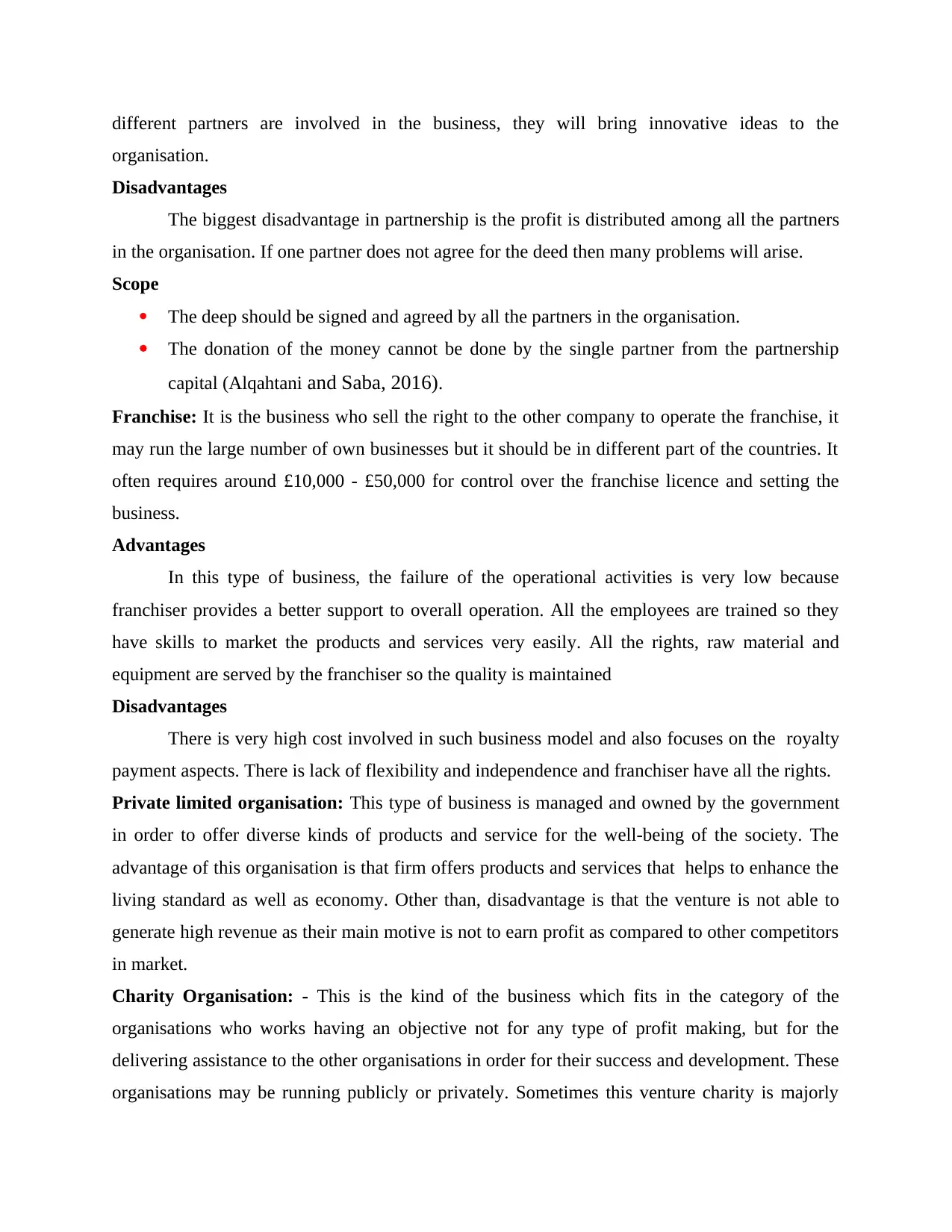
different partners are involved in the business, they will bring innovative ideas to the
organisation.
Disadvantages
The biggest disadvantage in partnership is the profit is distributed among all the partners
in the organisation. If one partner does not agree for the deed then many problems will arise.
Scope
The deep should be signed and agreed by all the partners in the organisation.
The donation of the money cannot be done by the single partner from the partnership
capital (Alqahtani and Saba, 2016).
Franchise: It is the business who sell the right to the other company to operate the franchise, it
may run the large number of own businesses but it should be in different part of the countries. It
often requires around £10,000 - £50,000 for control over the franchise licence and setting the
business.
Advantages
In this type of business, the failure of the operational activities is very low because
franchiser provides a better support to overall operation. All the employees are trained so they
have skills to market the products and services very easily. All the rights, raw material and
equipment are served by the franchiser so the quality is maintained
Disadvantages
There is very high cost involved in such business model and also focuses on the royalty
payment aspects. There is lack of flexibility and independence and franchiser have all the rights.
Private limited organisation: This type of business is managed and owned by the government
in order to offer diverse kinds of products and service for the well-being of the society. The
advantage of this organisation is that firm offers products and services that helps to enhance the
living standard as well as economy. Other than, disadvantage is that the venture is not able to
generate high revenue as their main motive is not to earn profit as compared to other competitors
in market.
Charity Organisation: - This is the kind of the business which fits in the category of the
organisations who works having an objective not for any type of profit making, but for the
delivering assistance to the other organisations in order for their success and development. These
organisations may be running publicly or privately. Sometimes this venture charity is majorly
organisation.
Disadvantages
The biggest disadvantage in partnership is the profit is distributed among all the partners
in the organisation. If one partner does not agree for the deed then many problems will arise.
Scope
The deep should be signed and agreed by all the partners in the organisation.
The donation of the money cannot be done by the single partner from the partnership
capital (Alqahtani and Saba, 2016).
Franchise: It is the business who sell the right to the other company to operate the franchise, it
may run the large number of own businesses but it should be in different part of the countries. It
often requires around £10,000 - £50,000 for control over the franchise licence and setting the
business.
Advantages
In this type of business, the failure of the operational activities is very low because
franchiser provides a better support to overall operation. All the employees are trained so they
have skills to market the products and services very easily. All the rights, raw material and
equipment are served by the franchiser so the quality is maintained
Disadvantages
There is very high cost involved in such business model and also focuses on the royalty
payment aspects. There is lack of flexibility and independence and franchiser have all the rights.
Private limited organisation: This type of business is managed and owned by the government
in order to offer diverse kinds of products and service for the well-being of the society. The
advantage of this organisation is that firm offers products and services that helps to enhance the
living standard as well as economy. Other than, disadvantage is that the venture is not able to
generate high revenue as their main motive is not to earn profit as compared to other competitors
in market.
Charity Organisation: - This is the kind of the business which fits in the category of the
organisations who works having an objective not for any type of profit making, but for the
delivering assistance to the other organisations in order for their success and development. These
organisations may be running publicly or privately. Sometimes this venture charity is majorly
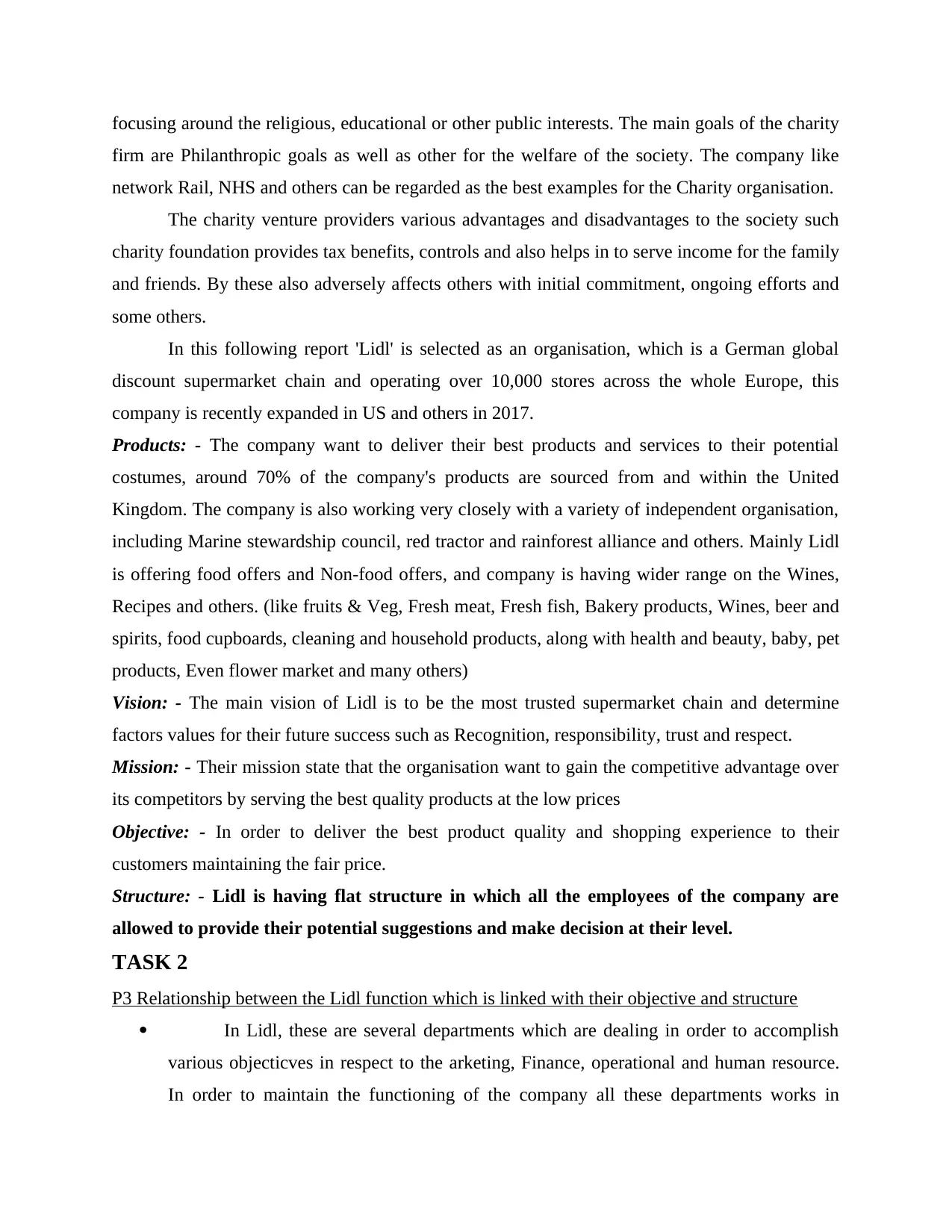
focusing around the religious, educational or other public interests. The main goals of the charity
firm are Philanthropic goals as well as other for the welfare of the society. The company like
network Rail, NHS and others can be regarded as the best examples for the Charity organisation.
The charity venture providers various advantages and disadvantages to the society such
charity foundation provides tax benefits, controls and also helps in to serve income for the family
and friends. By these also adversely affects others with initial commitment, ongoing efforts and
some others.
In this following report 'Lidl' is selected as an organisation, which is a German global
discount supermarket chain and operating over 10,000 stores across the whole Europe, this
company is recently expanded in US and others in 2017.
Products: - The company want to deliver their best products and services to their potential
costumes, around 70% of the company's products are sourced from and within the United
Kingdom. The company is also working very closely with a variety of independent organisation,
including Marine stewardship council, red tractor and rainforest alliance and others. Mainly Lidl
is offering food offers and Non-food offers, and company is having wider range on the Wines,
Recipes and others. (like fruits & Veg, Fresh meat, Fresh fish, Bakery products, Wines, beer and
spirits, food cupboards, cleaning and household products, along with health and beauty, baby, pet
products, Even flower market and many others)
Vision: - The main vision of Lidl is to be the most trusted supermarket chain and determine
factors values for their future success such as Recognition, responsibility, trust and respect.
Mission: - Their mission state that the organisation want to gain the competitive advantage over
its competitors by serving the best quality products at the low prices
Objective: - In order to deliver the best product quality and shopping experience to their
customers maintaining the fair price.
Structure: - Lidl is having flat structure in which all the employees of the company are
allowed to provide their potential suggestions and make decision at their level.
TASK 2
P3 Relationship between the Lidl function which is linked with their objective and structure
In Lidl, these are several departments which are dealing in order to accomplish
various objecticves in respect to the arketing, Finance, operational and human resource.
In order to maintain the functioning of the company all these departments works in
firm are Philanthropic goals as well as other for the welfare of the society. The company like
network Rail, NHS and others can be regarded as the best examples for the Charity organisation.
The charity venture providers various advantages and disadvantages to the society such
charity foundation provides tax benefits, controls and also helps in to serve income for the family
and friends. By these also adversely affects others with initial commitment, ongoing efforts and
some others.
In this following report 'Lidl' is selected as an organisation, which is a German global
discount supermarket chain and operating over 10,000 stores across the whole Europe, this
company is recently expanded in US and others in 2017.
Products: - The company want to deliver their best products and services to their potential
costumes, around 70% of the company's products are sourced from and within the United
Kingdom. The company is also working very closely with a variety of independent organisation,
including Marine stewardship council, red tractor and rainforest alliance and others. Mainly Lidl
is offering food offers and Non-food offers, and company is having wider range on the Wines,
Recipes and others. (like fruits & Veg, Fresh meat, Fresh fish, Bakery products, Wines, beer and
spirits, food cupboards, cleaning and household products, along with health and beauty, baby, pet
products, Even flower market and many others)
Vision: - The main vision of Lidl is to be the most trusted supermarket chain and determine
factors values for their future success such as Recognition, responsibility, trust and respect.
Mission: - Their mission state that the organisation want to gain the competitive advantage over
its competitors by serving the best quality products at the low prices
Objective: - In order to deliver the best product quality and shopping experience to their
customers maintaining the fair price.
Structure: - Lidl is having flat structure in which all the employees of the company are
allowed to provide their potential suggestions and make decision at their level.
TASK 2
P3 Relationship between the Lidl function which is linked with their objective and structure
In Lidl, these are several departments which are dealing in order to accomplish
various objecticves in respect to the arketing, Finance, operational and human resource.
In order to maintain the functioning of the company all these departments works in
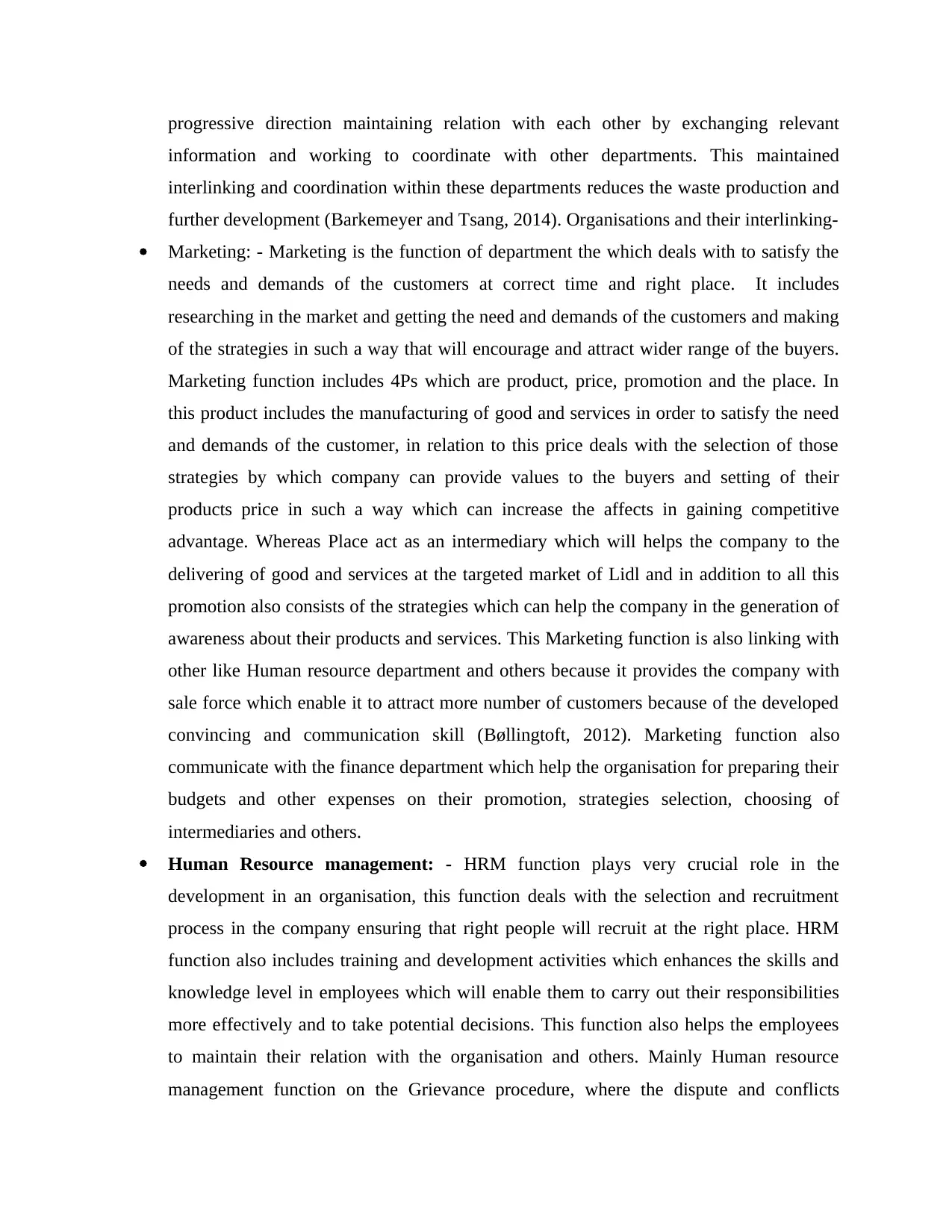
progressive direction maintaining relation with each other by exchanging relevant
information and working to coordinate with other departments. This maintained
interlinking and coordination within these departments reduces the waste production and
further development (Barkemeyer and Tsang, 2014). Organisations and their interlinking-
Marketing: - Marketing is the function of department the which deals with to satisfy the
needs and demands of the customers at correct time and right place. It includes
researching in the market and getting the need and demands of the customers and making
of the strategies in such a way that will encourage and attract wider range of the buyers.
Marketing function includes 4Ps which are product, price, promotion and the place. In
this product includes the manufacturing of good and services in order to satisfy the need
and demands of the customer, in relation to this price deals with the selection of those
strategies by which company can provide values to the buyers and setting of their
products price in such a way which can increase the affects in gaining competitive
advantage. Whereas Place act as an intermediary which will helps the company to the
delivering of good and services at the targeted market of Lidl and in addition to all this
promotion also consists of the strategies which can help the company in the generation of
awareness about their products and services. This Marketing function is also linking with
other like Human resource department and others because it provides the company with
sale force which enable it to attract more number of customers because of the developed
convincing and communication skill (Bøllingtoft, 2012). Marketing function also
communicate with the finance department which help the organisation for preparing their
budgets and other expenses on their promotion, strategies selection, choosing of
intermediaries and others.
Human Resource management: - HRM function plays very crucial role in the
development in an organisation, this function deals with the selection and recruitment
process in the company ensuring that right people will recruit at the right place. HRM
function also includes training and development activities which enhances the skills and
knowledge level in employees which will enable them to carry out their responsibilities
more effectively and to take potential decisions. This function also helps the employees
to maintain their relation with the organisation and others. Mainly Human resource
management function on the Grievance procedure, where the dispute and conflicts
information and working to coordinate with other departments. This maintained
interlinking and coordination within these departments reduces the waste production and
further development (Barkemeyer and Tsang, 2014). Organisations and their interlinking-
Marketing: - Marketing is the function of department the which deals with to satisfy the
needs and demands of the customers at correct time and right place. It includes
researching in the market and getting the need and demands of the customers and making
of the strategies in such a way that will encourage and attract wider range of the buyers.
Marketing function includes 4Ps which are product, price, promotion and the place. In
this product includes the manufacturing of good and services in order to satisfy the need
and demands of the customer, in relation to this price deals with the selection of those
strategies by which company can provide values to the buyers and setting of their
products price in such a way which can increase the affects in gaining competitive
advantage. Whereas Place act as an intermediary which will helps the company to the
delivering of good and services at the targeted market of Lidl and in addition to all this
promotion also consists of the strategies which can help the company in the generation of
awareness about their products and services. This Marketing function is also linking with
other like Human resource department and others because it provides the company with
sale force which enable it to attract more number of customers because of the developed
convincing and communication skill (Bøllingtoft, 2012). Marketing function also
communicate with the finance department which help the organisation for preparing their
budgets and other expenses on their promotion, strategies selection, choosing of
intermediaries and others.
Human Resource management: - HRM function plays very crucial role in the
development in an organisation, this function deals with the selection and recruitment
process in the company ensuring that right people will recruit at the right place. HRM
function also includes training and development activities which enhances the skills and
knowledge level in employees which will enable them to carry out their responsibilities
more effectively and to take potential decisions. This function also helps the employees
to maintain their relation with the organisation and others. Mainly Human resource
management function on the Grievance procedure, where the dispute and conflicts
Paraphrase This Document
Need a fresh take? Get an instant paraphrase of this document with our AI Paraphraser
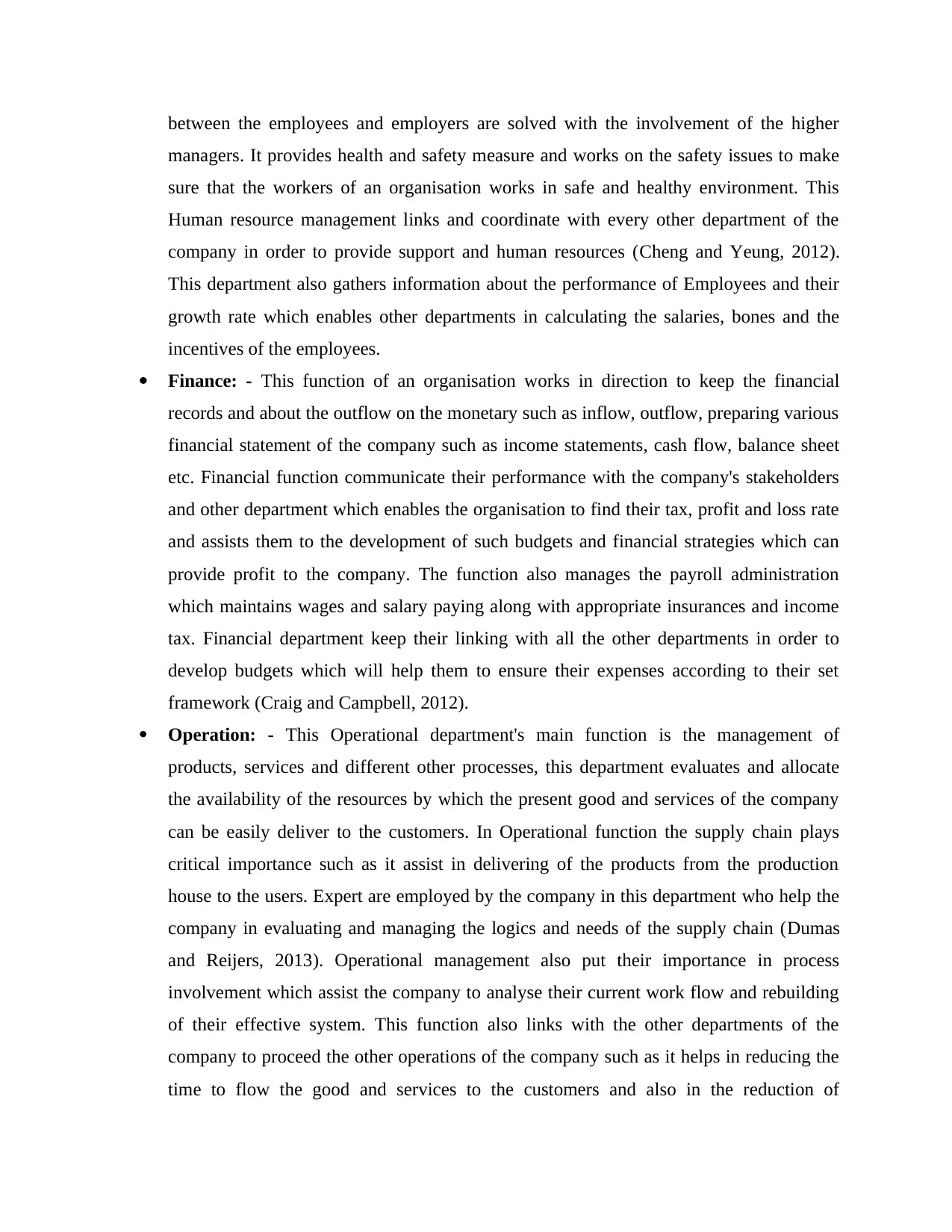
between the employees and employers are solved with the involvement of the higher
managers. It provides health and safety measure and works on the safety issues to make
sure that the workers of an organisation works in safe and healthy environment. This
Human resource management links and coordinate with every other department of the
company in order to provide support and human resources (Cheng and Yeung, 2012).
This department also gathers information about the performance of Employees and their
growth rate which enables other departments in calculating the salaries, bones and the
incentives of the employees.
Finance: - This function of an organisation works in direction to keep the financial
records and about the outflow on the monetary such as inflow, outflow, preparing various
financial statement of the company such as income statements, cash flow, balance sheet
etc. Financial function communicate their performance with the company's stakeholders
and other department which enables the organisation to find their tax, profit and loss rate
and assists them to the development of such budgets and financial strategies which can
provide profit to the company. The function also manages the payroll administration
which maintains wages and salary paying along with appropriate insurances and income
tax. Financial department keep their linking with all the other departments in order to
develop budgets which will help them to ensure their expenses according to their set
framework (Craig and Campbell, 2012).
Operation: - This Operational department's main function is the management of
products, services and different other processes, this department evaluates and allocate
the availability of the resources by which the present good and services of the company
can be easily deliver to the customers. In Operational function the supply chain plays
critical importance such as it assist in delivering of the products from the production
house to the users. Expert are employed by the company in this department who help the
company in evaluating and managing the logics and needs of the supply chain (Dumas
and Reijers, 2013). Operational management also put their importance in process
involvement which assist the company to analyse their current work flow and rebuilding
of their effective system. This function also links with the other departments of the
company to proceed the other operations of the company such as it helps in reducing the
time to flow the good and services to the customers and also in the reduction of
managers. It provides health and safety measure and works on the safety issues to make
sure that the workers of an organisation works in safe and healthy environment. This
Human resource management links and coordinate with every other department of the
company in order to provide support and human resources (Cheng and Yeung, 2012).
This department also gathers information about the performance of Employees and their
growth rate which enables other departments in calculating the salaries, bones and the
incentives of the employees.
Finance: - This function of an organisation works in direction to keep the financial
records and about the outflow on the monetary such as inflow, outflow, preparing various
financial statement of the company such as income statements, cash flow, balance sheet
etc. Financial function communicate their performance with the company's stakeholders
and other department which enables the organisation to find their tax, profit and loss rate
and assists them to the development of such budgets and financial strategies which can
provide profit to the company. The function also manages the payroll administration
which maintains wages and salary paying along with appropriate insurances and income
tax. Financial department keep their linking with all the other departments in order to
develop budgets which will help them to ensure their expenses according to their set
framework (Craig and Campbell, 2012).
Operation: - This Operational department's main function is the management of
products, services and different other processes, this department evaluates and allocate
the availability of the resources by which the present good and services of the company
can be easily deliver to the customers. In Operational function the supply chain plays
critical importance such as it assist in delivering of the products from the production
house to the users. Expert are employed by the company in this department who help the
company in evaluating and managing the logics and needs of the supply chain (Dumas
and Reijers, 2013). Operational management also put their importance in process
involvement which assist the company to analyse their current work flow and rebuilding
of their effective system. This function also links with the other departments of the
company to proceed the other operations of the company such as it helps in reducing the
time to flow the good and services to the customers and also in the reduction of
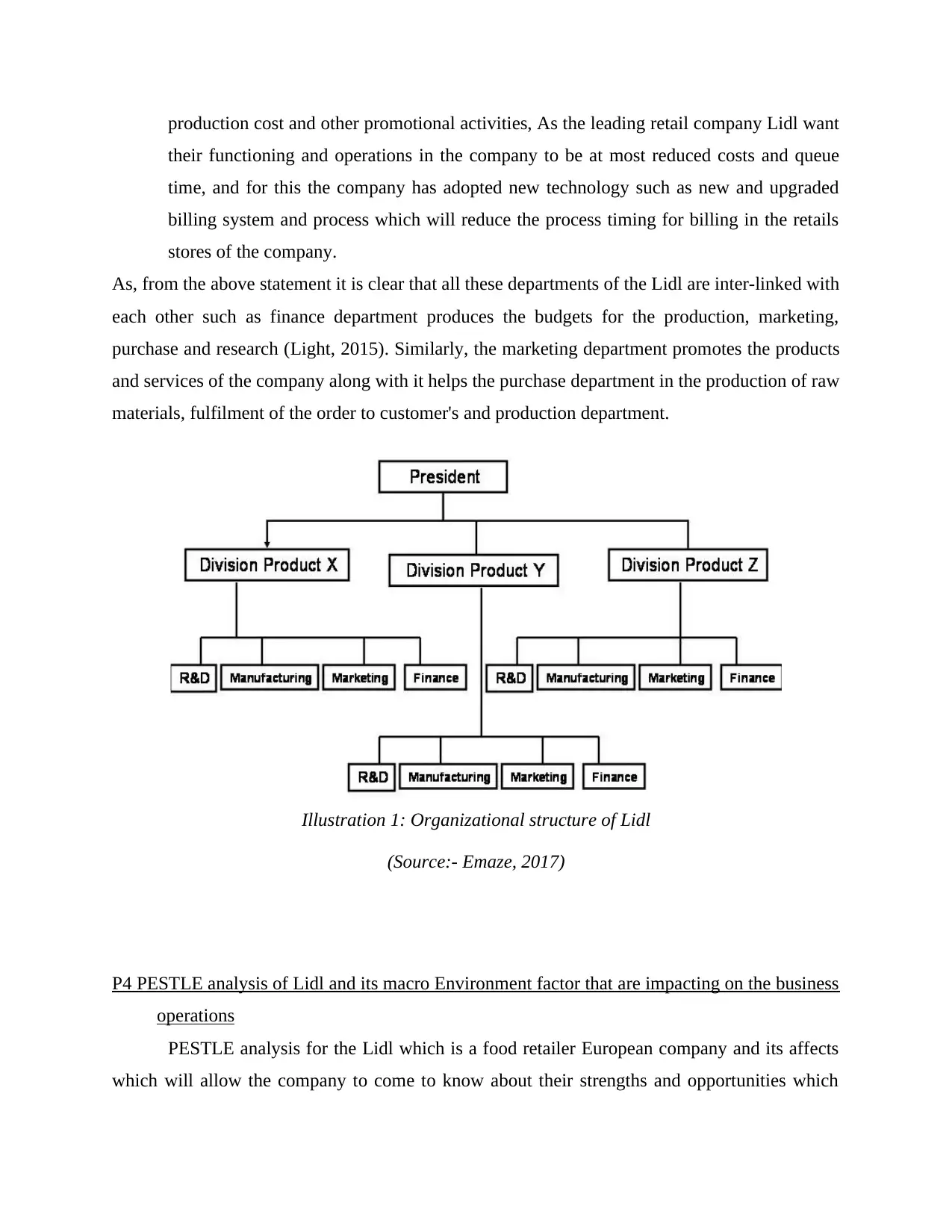
production cost and other promotional activities, As the leading retail company Lidl want
their functioning and operations in the company to be at most reduced costs and queue
time, and for this the company has adopted new technology such as new and upgraded
billing system and process which will reduce the process timing for billing in the retails
stores of the company.
As, from the above statement it is clear that all these departments of the Lidl are inter-linked with
each other such as finance department produces the budgets for the production, marketing,
purchase and research (Light, 2015). Similarly, the marketing department promotes the products
and services of the company along with it helps the purchase department in the production of raw
materials, fulfilment of the order to customer's and production department.
P4 PESTLE analysis of Lidl and its macro Environment factor that are impacting on the business
operations
PESTLE analysis for the Lidl which is a food retailer European company and its affects
which will allow the company to come to know about their strengths and opportunities which
Illustration 1: Organizational structure of Lidl
(Source:- Emaze, 2017)
their functioning and operations in the company to be at most reduced costs and queue
time, and for this the company has adopted new technology such as new and upgraded
billing system and process which will reduce the process timing for billing in the retails
stores of the company.
As, from the above statement it is clear that all these departments of the Lidl are inter-linked with
each other such as finance department produces the budgets for the production, marketing,
purchase and research (Light, 2015). Similarly, the marketing department promotes the products
and services of the company along with it helps the purchase department in the production of raw
materials, fulfilment of the order to customer's and production department.
P4 PESTLE analysis of Lidl and its macro Environment factor that are impacting on the business
operations
PESTLE analysis for the Lidl which is a food retailer European company and its affects
which will allow the company to come to know about their strengths and opportunities which
Illustration 1: Organizational structure of Lidl
(Source:- Emaze, 2017)
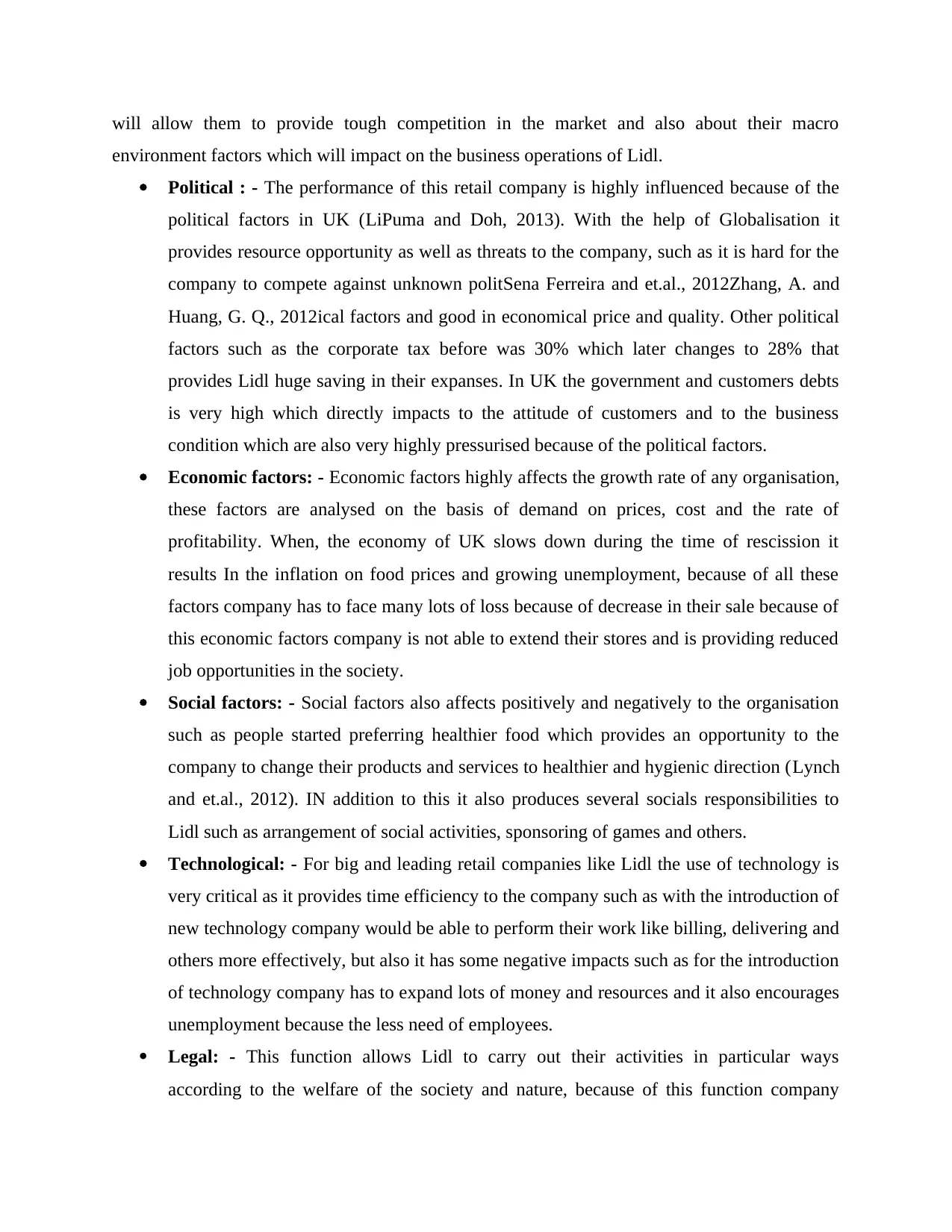
will allow them to provide tough competition in the market and also about their macro
environment factors which will impact on the business operations of Lidl.
Political : - The performance of this retail company is highly influenced because of the
political factors in UK (LiPuma and Doh, 2013). With the help of Globalisation it
provides resource opportunity as well as threats to the company, such as it is hard for the
company to compete against unknown politSena Ferreira and et.al., 2012Zhang, A. and
Huang, G. Q., 2012ical factors and good in economical price and quality. Other political
factors such as the corporate tax before was 30% which later changes to 28% that
provides Lidl huge saving in their expanses. In UK the government and customers debts
is very high which directly impacts to the attitude of customers and to the business
condition which are also very highly pressurised because of the political factors.
Economic factors: - Economic factors highly affects the growth rate of any organisation,
these factors are analysed on the basis of demand on prices, cost and the rate of
profitability. When, the economy of UK slows down during the time of rescission it
results In the inflation on food prices and growing unemployment, because of all these
factors company has to face many lots of loss because of decrease in their sale because of
this economic factors company is not able to extend their stores and is providing reduced
job opportunities in the society.
Social factors: - Social factors also affects positively and negatively to the organisation
such as people started preferring healthier food which provides an opportunity to the
company to change their products and services to healthier and hygienic direction (Lynch
and et.al., 2012). IN addition to this it also produces several socials responsibilities to
Lidl such as arrangement of social activities, sponsoring of games and others.
Technological: - For big and leading retail companies like Lidl the use of technology is
very critical as it provides time efficiency to the company such as with the introduction of
new technology company would be able to perform their work like billing, delivering and
others more effectively, but also it has some negative impacts such as for the introduction
of technology company has to expand lots of money and resources and it also encourages
unemployment because the less need of employees.
Legal: - This function allows Lidl to carry out their activities in particular ways
according to the welfare of the society and nature, because of this function company
environment factors which will impact on the business operations of Lidl.
Political : - The performance of this retail company is highly influenced because of the
political factors in UK (LiPuma and Doh, 2013). With the help of Globalisation it
provides resource opportunity as well as threats to the company, such as it is hard for the
company to compete against unknown politSena Ferreira and et.al., 2012Zhang, A. and
Huang, G. Q., 2012ical factors and good in economical price and quality. Other political
factors such as the corporate tax before was 30% which later changes to 28% that
provides Lidl huge saving in their expanses. In UK the government and customers debts
is very high which directly impacts to the attitude of customers and to the business
condition which are also very highly pressurised because of the political factors.
Economic factors: - Economic factors highly affects the growth rate of any organisation,
these factors are analysed on the basis of demand on prices, cost and the rate of
profitability. When, the economy of UK slows down during the time of rescission it
results In the inflation on food prices and growing unemployment, because of all these
factors company has to face many lots of loss because of decrease in their sale because of
this economic factors company is not able to extend their stores and is providing reduced
job opportunities in the society.
Social factors: - Social factors also affects positively and negatively to the organisation
such as people started preferring healthier food which provides an opportunity to the
company to change their products and services to healthier and hygienic direction (Lynch
and et.al., 2012). IN addition to this it also produces several socials responsibilities to
Lidl such as arrangement of social activities, sponsoring of games and others.
Technological: - For big and leading retail companies like Lidl the use of technology is
very critical as it provides time efficiency to the company such as with the introduction of
new technology company would be able to perform their work like billing, delivering and
others more effectively, but also it has some negative impacts such as for the introduction
of technology company has to expand lots of money and resources and it also encourages
unemployment because the less need of employees.
Legal: - This function allows Lidl to carry out their activities in particular ways
according to the welfare of the society and nature, because of this function company
Secure Best Marks with AI Grader
Need help grading? Try our AI Grader for instant feedback on your assignments.
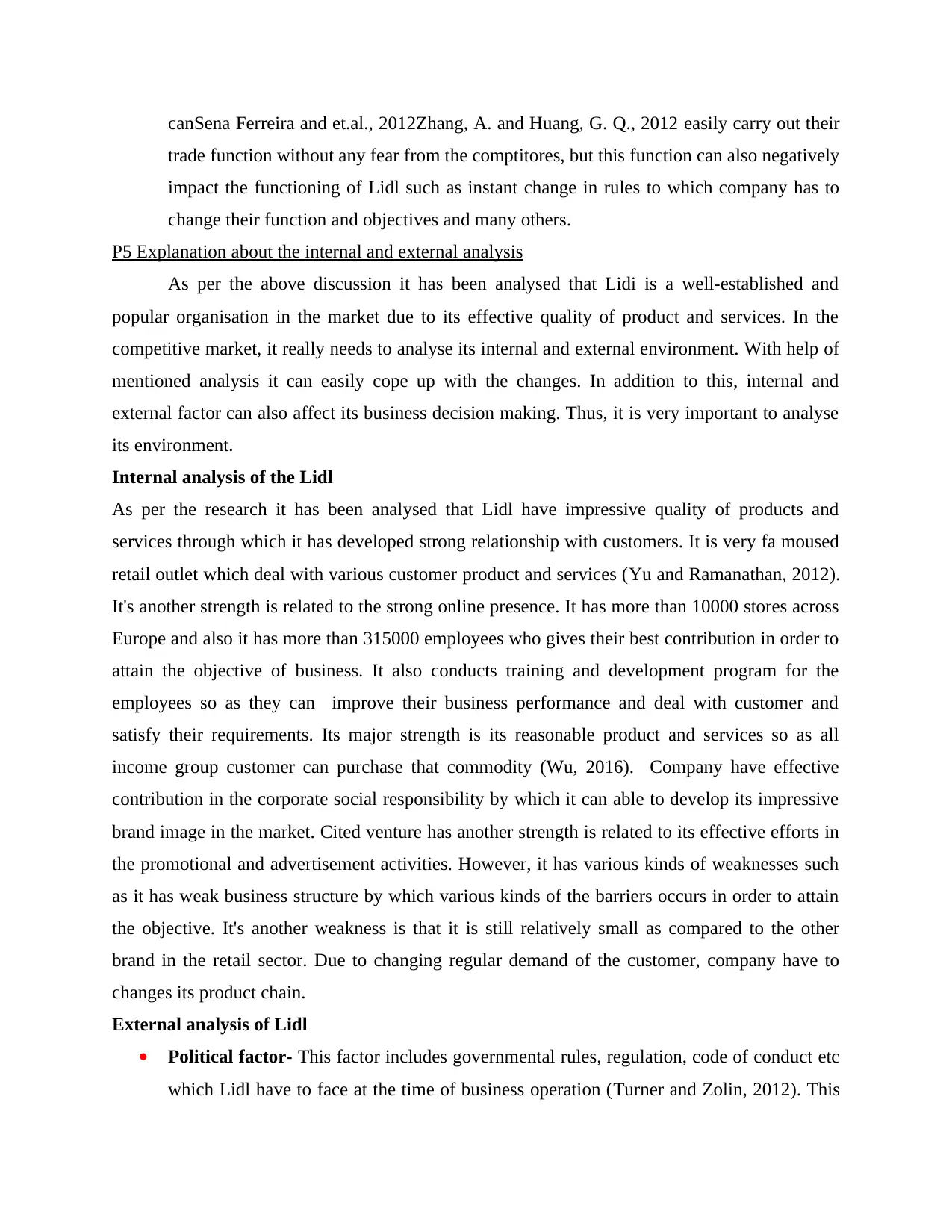
canSena Ferreira and et.al., 2012Zhang, A. and Huang, G. Q., 2012 easily carry out their
trade function without any fear from the comptitores, but this function can also negatively
impact the functioning of Lidl such as instant change in rules to which company has to
change their function and objectives and many others.
P5 Explanation about the internal and external analysis
As per the above discussion it has been analysed that Lidi is a well-established and
popular organisation in the market due to its effective quality of product and services. In the
competitive market, it really needs to analyse its internal and external environment. With help of
mentioned analysis it can easily cope up with the changes. In addition to this, internal and
external factor can also affect its business decision making. Thus, it is very important to analyse
its environment.
Internal analysis of the Lidl
As per the research it has been analysed that Lidl have impressive quality of products and
services through which it has developed strong relationship with customers. It is very fa moused
retail outlet which deal with various customer product and services (Yu and Ramanathan, 2012).
It's another strength is related to the strong online presence. It has more than 10000 stores across
Europe and also it has more than 315000 employees who gives their best contribution in order to
attain the objective of business. It also conducts training and development program for the
employees so as they can improve their business performance and deal with customer and
satisfy their requirements. Its major strength is its reasonable product and services so as all
income group customer can purchase that commodity (Wu, 2016). Company have effective
contribution in the corporate social responsibility by which it can able to develop its impressive
brand image in the market. Cited venture has another strength is related to its effective efforts in
the promotional and advertisement activities. However, it has various kinds of weaknesses such
as it has weak business structure by which various kinds of the barriers occurs in order to attain
the objective. It's another weakness is that it is still relatively small as compared to the other
brand in the retail sector. Due to changing regular demand of the customer, company have to
changes its product chain.
External analysis of Lidl
Political factor- This factor includes governmental rules, regulation, code of conduct etc
which Lidl have to face at the time of business operation (Turner and Zolin, 2012). This
trade function without any fear from the comptitores, but this function can also negatively
impact the functioning of Lidl such as instant change in rules to which company has to
change their function and objectives and many others.
P5 Explanation about the internal and external analysis
As per the above discussion it has been analysed that Lidi is a well-established and
popular organisation in the market due to its effective quality of product and services. In the
competitive market, it really needs to analyse its internal and external environment. With help of
mentioned analysis it can easily cope up with the changes. In addition to this, internal and
external factor can also affect its business decision making. Thus, it is very important to analyse
its environment.
Internal analysis of the Lidl
As per the research it has been analysed that Lidl have impressive quality of products and
services through which it has developed strong relationship with customers. It is very fa moused
retail outlet which deal with various customer product and services (Yu and Ramanathan, 2012).
It's another strength is related to the strong online presence. It has more than 10000 stores across
Europe and also it has more than 315000 employees who gives their best contribution in order to
attain the objective of business. It also conducts training and development program for the
employees so as they can improve their business performance and deal with customer and
satisfy their requirements. Its major strength is its reasonable product and services so as all
income group customer can purchase that commodity (Wu, 2016). Company have effective
contribution in the corporate social responsibility by which it can able to develop its impressive
brand image in the market. Cited venture has another strength is related to its effective efforts in
the promotional and advertisement activities. However, it has various kinds of weaknesses such
as it has weak business structure by which various kinds of the barriers occurs in order to attain
the objective. It's another weakness is that it is still relatively small as compared to the other
brand in the retail sector. Due to changing regular demand of the customer, company have to
changes its product chain.
External analysis of Lidl
Political factor- This factor includes governmental rules, regulation, code of conduct etc
which Lidl have to face at the time of business operation (Turner and Zolin, 2012). This
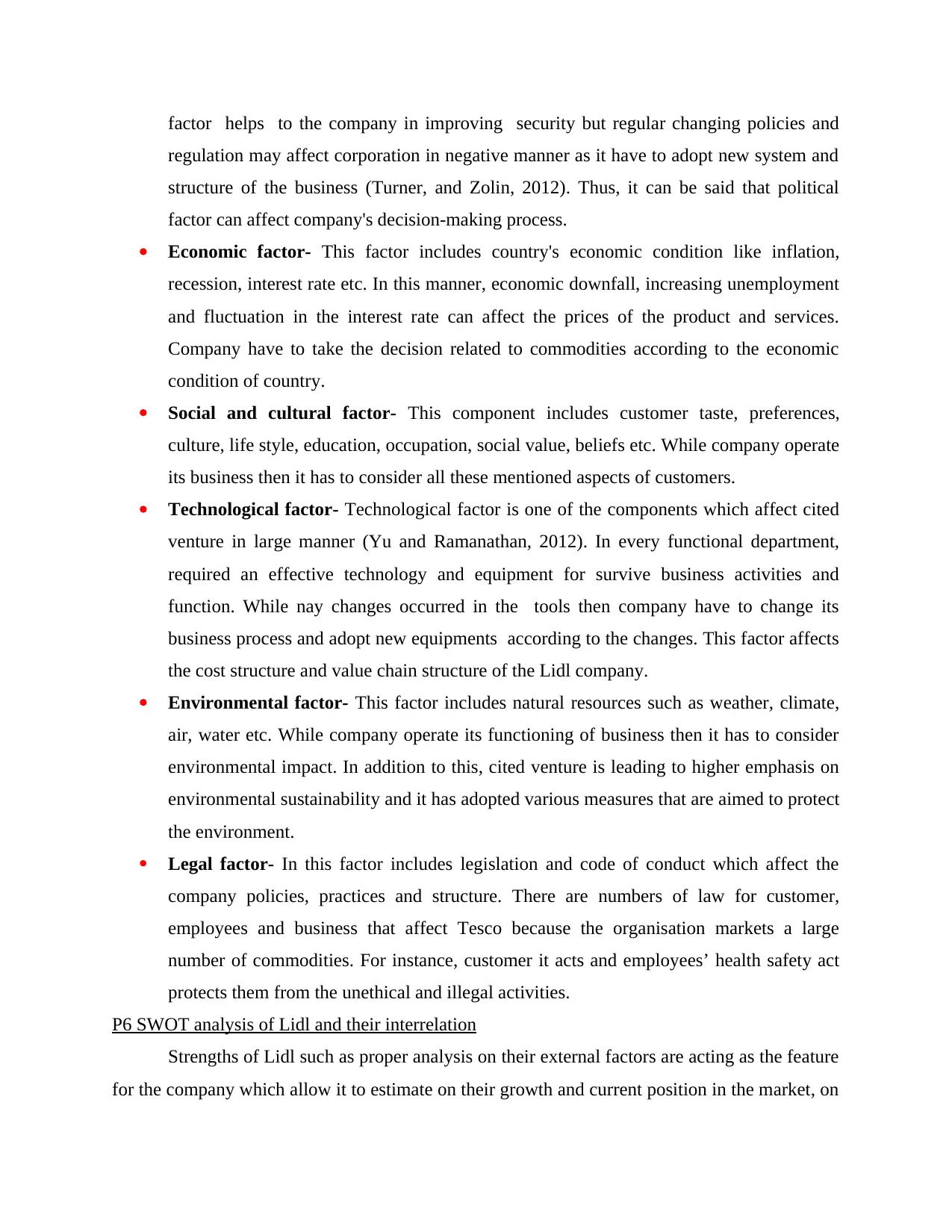
factor helps to the company in improving security but regular changing policies and
regulation may affect corporation in negative manner as it have to adopt new system and
structure of the business (Turner, and Zolin, 2012). Thus, it can be said that political
factor can affect company's decision-making process.
Economic factor- This factor includes country's economic condition like inflation,
recession, interest rate etc. In this manner, economic downfall, increasing unemployment
and fluctuation in the interest rate can affect the prices of the product and services.
Company have to take the decision related to commodities according to the economic
condition of country.
Social and cultural factor- This component includes customer taste, preferences,
culture, life style, education, occupation, social value, beliefs etc. While company operate
its business then it has to consider all these mentioned aspects of customers.
Technological factor- Technological factor is one of the components which affect cited
venture in large manner (Yu and Ramanathan, 2012). In every functional department,
required an effective technology and equipment for survive business activities and
function. While nay changes occurred in the tools then company have to change its
business process and adopt new equipments according to the changes. This factor affects
the cost structure and value chain structure of the Lidl company.
Environmental factor- This factor includes natural resources such as weather, climate,
air, water etc. While company operate its functioning of business then it has to consider
environmental impact. In addition to this, cited venture is leading to higher emphasis on
environmental sustainability and it has adopted various measures that are aimed to protect
the environment.
Legal factor- In this factor includes legislation and code of conduct which affect the
company policies, practices and structure. There are numbers of law for customer,
employees and business that affect Tesco because the organisation markets a large
number of commodities. For instance, customer it acts and employees’ health safety act
protects them from the unethical and illegal activities.
P6 SWOT analysis of Lidl and their interrelation
Strengths of Lidl such as proper analysis on their external factors are acting as the feature
for the company which allow it to estimate on their growth and current position in the market, on
regulation may affect corporation in negative manner as it have to adopt new system and
structure of the business (Turner, and Zolin, 2012). Thus, it can be said that political
factor can affect company's decision-making process.
Economic factor- This factor includes country's economic condition like inflation,
recession, interest rate etc. In this manner, economic downfall, increasing unemployment
and fluctuation in the interest rate can affect the prices of the product and services.
Company have to take the decision related to commodities according to the economic
condition of country.
Social and cultural factor- This component includes customer taste, preferences,
culture, life style, education, occupation, social value, beliefs etc. While company operate
its business then it has to consider all these mentioned aspects of customers.
Technological factor- Technological factor is one of the components which affect cited
venture in large manner (Yu and Ramanathan, 2012). In every functional department,
required an effective technology and equipment for survive business activities and
function. While nay changes occurred in the tools then company have to change its
business process and adopt new equipments according to the changes. This factor affects
the cost structure and value chain structure of the Lidl company.
Environmental factor- This factor includes natural resources such as weather, climate,
air, water etc. While company operate its functioning of business then it has to consider
environmental impact. In addition to this, cited venture is leading to higher emphasis on
environmental sustainability and it has adopted various measures that are aimed to protect
the environment.
Legal factor- In this factor includes legislation and code of conduct which affect the
company policies, practices and structure. There are numbers of law for customer,
employees and business that affect Tesco because the organisation markets a large
number of commodities. For instance, customer it acts and employees’ health safety act
protects them from the unethical and illegal activities.
P6 SWOT analysis of Lidl and their interrelation
Strengths of Lidl such as proper analysis on their external factors are acting as the feature
for the company which allow it to estimate on their growth and current position in the market, on
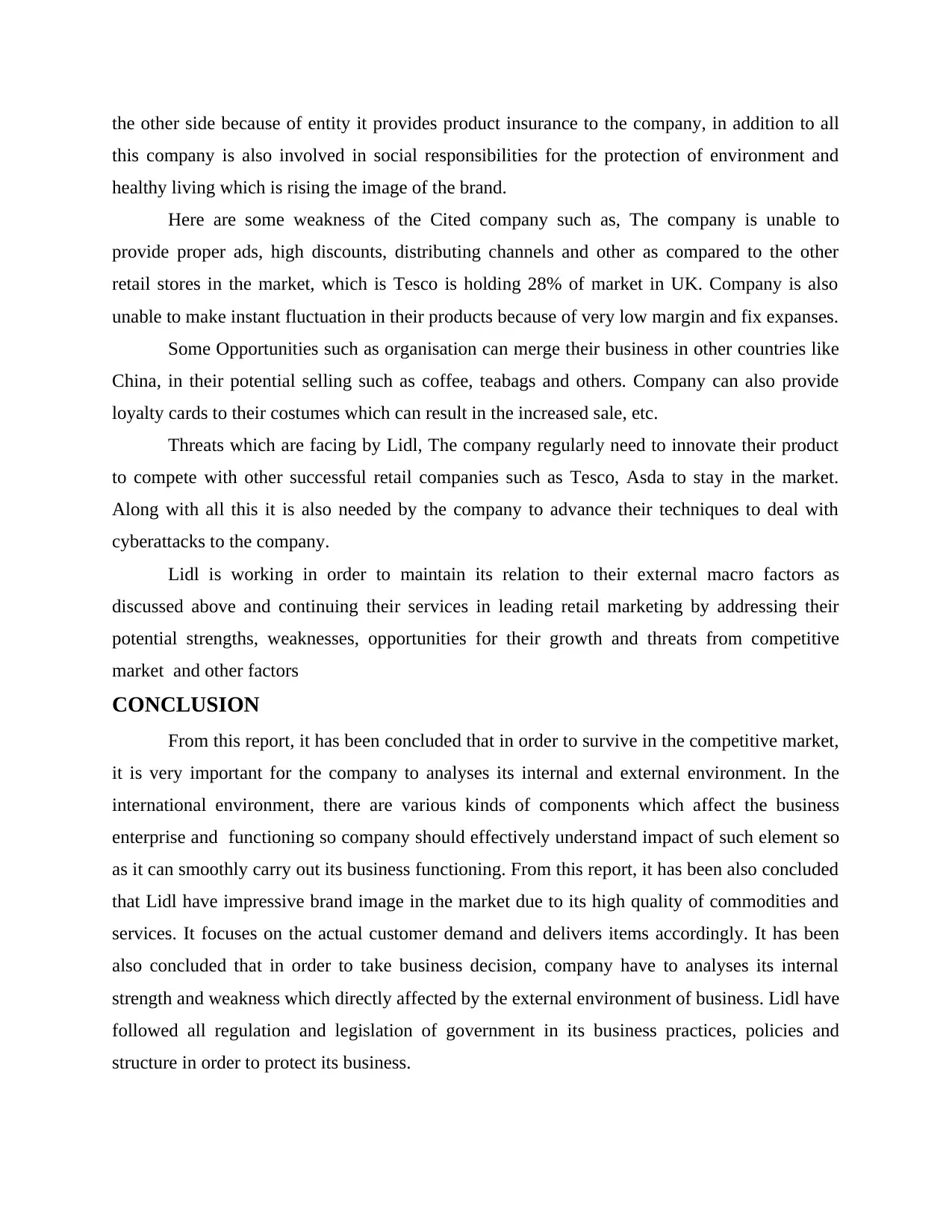
the other side because of entity it provides product insurance to the company, in addition to all
this company is also involved in social responsibilities for the protection of environment and
healthy living which is rising the image of the brand.
Here are some weakness of the Cited company such as, The company is unable to
provide proper ads, high discounts, distributing channels and other as compared to the other
retail stores in the market, which is Tesco is holding 28% of market in UK. Company is also
unable to make instant fluctuation in their products because of very low margin and fix expanses.
Some Opportunities such as organisation can merge their business in other countries like
China, in their potential selling such as coffee, teabags and others. Company can also provide
loyalty cards to their costumes which can result in the increased sale, etc.
Threats which are facing by Lidl, The company regularly need to innovate their product
to compete with other successful retail companies such as Tesco, Asda to stay in the market.
Along with all this it is also needed by the company to advance their techniques to deal with
cyberattacks to the company.
Lidl is working in order to maintain its relation to their external macro factors as
discussed above and continuing their services in leading retail marketing by addressing their
potential strengths, weaknesses, opportunities for their growth and threats from competitive
market and other factors
CONCLUSION
From this report, it has been concluded that in order to survive in the competitive market,
it is very important for the company to analyses its internal and external environment. In the
international environment, there are various kinds of components which affect the business
enterprise and functioning so company should effectively understand impact of such element so
as it can smoothly carry out its business functioning. From this report, it has been also concluded
that Lidl have impressive brand image in the market due to its high quality of commodities and
services. It focuses on the actual customer demand and delivers items accordingly. It has been
also concluded that in order to take business decision, company have to analyses its internal
strength and weakness which directly affected by the external environment of business. Lidl have
followed all regulation and legislation of government in its business practices, policies and
structure in order to protect its business.
this company is also involved in social responsibilities for the protection of environment and
healthy living which is rising the image of the brand.
Here are some weakness of the Cited company such as, The company is unable to
provide proper ads, high discounts, distributing channels and other as compared to the other
retail stores in the market, which is Tesco is holding 28% of market in UK. Company is also
unable to make instant fluctuation in their products because of very low margin and fix expanses.
Some Opportunities such as organisation can merge their business in other countries like
China, in their potential selling such as coffee, teabags and others. Company can also provide
loyalty cards to their costumes which can result in the increased sale, etc.
Threats which are facing by Lidl, The company regularly need to innovate their product
to compete with other successful retail companies such as Tesco, Asda to stay in the market.
Along with all this it is also needed by the company to advance their techniques to deal with
cyberattacks to the company.
Lidl is working in order to maintain its relation to their external macro factors as
discussed above and continuing their services in leading retail marketing by addressing their
potential strengths, weaknesses, opportunities for their growth and threats from competitive
market and other factors
CONCLUSION
From this report, it has been concluded that in order to survive in the competitive market,
it is very important for the company to analyses its internal and external environment. In the
international environment, there are various kinds of components which affect the business
enterprise and functioning so company should effectively understand impact of such element so
as it can smoothly carry out its business functioning. From this report, it has been also concluded
that Lidl have impressive brand image in the market due to its high quality of commodities and
services. It focuses on the actual customer demand and delivers items accordingly. It has been
also concluded that in order to take business decision, company have to analyses its internal
strength and weakness which directly affected by the external environment of business. Lidl have
followed all regulation and legislation of government in its business practices, policies and
structure in order to protect its business.
Paraphrase This Document
Need a fresh take? Get an instant paraphrase of this document with our AI Paraphraser
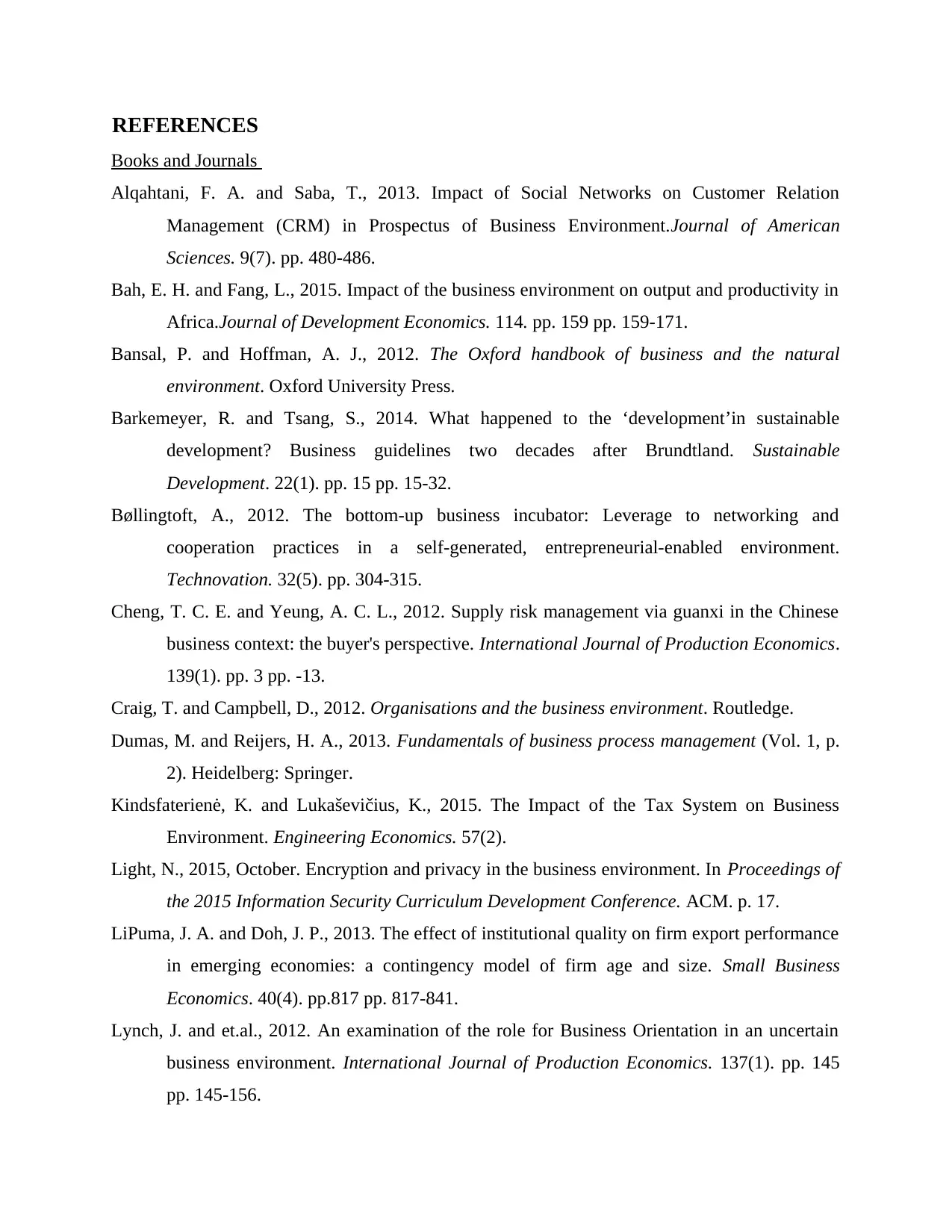
REFERENCES
Books and Journals
Alqahtani, F. A. and Saba, T., 2013. Impact of Social Networks on Customer Relation
Management (CRM) in Prospectus of Business Environment.Journal of American
Sciences. 9(7). pp. 480-486.
Bah, E. H. and Fang, L., 2015. Impact of the business environment on output and productivity in
Africa.Journal of Development Economics. 114. pp. 159 pp. 159-171.
Bansal, P. and Hoffman, A. J., 2012. The Oxford handbook of business and the natural
environment. Oxford University Press.
Barkemeyer, R. and Tsang, S., 2014. What happened to the ‘development’in sustainable
development? Business guidelines two decades after Brundtland. Sustainable
Development. 22(1). pp. 15 pp. 15-32.
Bøllingtoft, A., 2012. The bottom-up business incubator: Leverage to networking and
cooperation practices in a self-generated, entrepreneurial-enabled environment.
Technovation. 32(5). pp. 304-315.
Cheng, T. C. E. and Yeung, A. C. L., 2012. Supply risk management via guanxi in the Chinese
business context: the buyer's perspective. International Journal of Production Economics.
139(1). pp. 3 pp. -13.
Craig, T. and Campbell, D., 2012. Organisations and the business environment. Routledge.
Dumas, M. and Reijers, H. A., 2013. Fundamentals of business process management (Vol. 1, p.
2). Heidelberg: Springer.
Kindsfaterienė, K. and Lukaševičius, K., 2015. The Impact of the Tax System on Business
Environment. Engineering Economics. 57(2).
Light, N., 2015, October. Encryption and privacy in the business environment. In Proceedings of
the 2015 Information Security Curriculum Development Conference. ACM. p. 17.
LiPuma, J. A. and Doh, J. P., 2013. The effect of institutional quality on firm export performance
in emerging economies: a contingency model of firm age and size. Small Business
Economics. 40(4). pp.817 pp. 817-841.
Lynch, J. and et.al., 2012. An examination of the role for Business Orientation in an uncertain
business environment. International Journal of Production Economics. 137(1). pp. 145
pp. 145-156.
Books and Journals
Alqahtani, F. A. and Saba, T., 2013. Impact of Social Networks on Customer Relation
Management (CRM) in Prospectus of Business Environment.Journal of American
Sciences. 9(7). pp. 480-486.
Bah, E. H. and Fang, L., 2015. Impact of the business environment on output and productivity in
Africa.Journal of Development Economics. 114. pp. 159 pp. 159-171.
Bansal, P. and Hoffman, A. J., 2012. The Oxford handbook of business and the natural
environment. Oxford University Press.
Barkemeyer, R. and Tsang, S., 2014. What happened to the ‘development’in sustainable
development? Business guidelines two decades after Brundtland. Sustainable
Development. 22(1). pp. 15 pp. 15-32.
Bøllingtoft, A., 2012. The bottom-up business incubator: Leverage to networking and
cooperation practices in a self-generated, entrepreneurial-enabled environment.
Technovation. 32(5). pp. 304-315.
Cheng, T. C. E. and Yeung, A. C. L., 2012. Supply risk management via guanxi in the Chinese
business context: the buyer's perspective. International Journal of Production Economics.
139(1). pp. 3 pp. -13.
Craig, T. and Campbell, D., 2012. Organisations and the business environment. Routledge.
Dumas, M. and Reijers, H. A., 2013. Fundamentals of business process management (Vol. 1, p.
2). Heidelberg: Springer.
Kindsfaterienė, K. and Lukaševičius, K., 2015. The Impact of the Tax System on Business
Environment. Engineering Economics. 57(2).
Light, N., 2015, October. Encryption and privacy in the business environment. In Proceedings of
the 2015 Information Security Curriculum Development Conference. ACM. p. 17.
LiPuma, J. A. and Doh, J. P., 2013. The effect of institutional quality on firm export performance
in emerging economies: a contingency model of firm age and size. Small Business
Economics. 40(4). pp.817 pp. 817-841.
Lynch, J. and et.al., 2012. An examination of the role for Business Orientation in an uncertain
business environment. International Journal of Production Economics. 137(1). pp. 145
pp. 145-156.
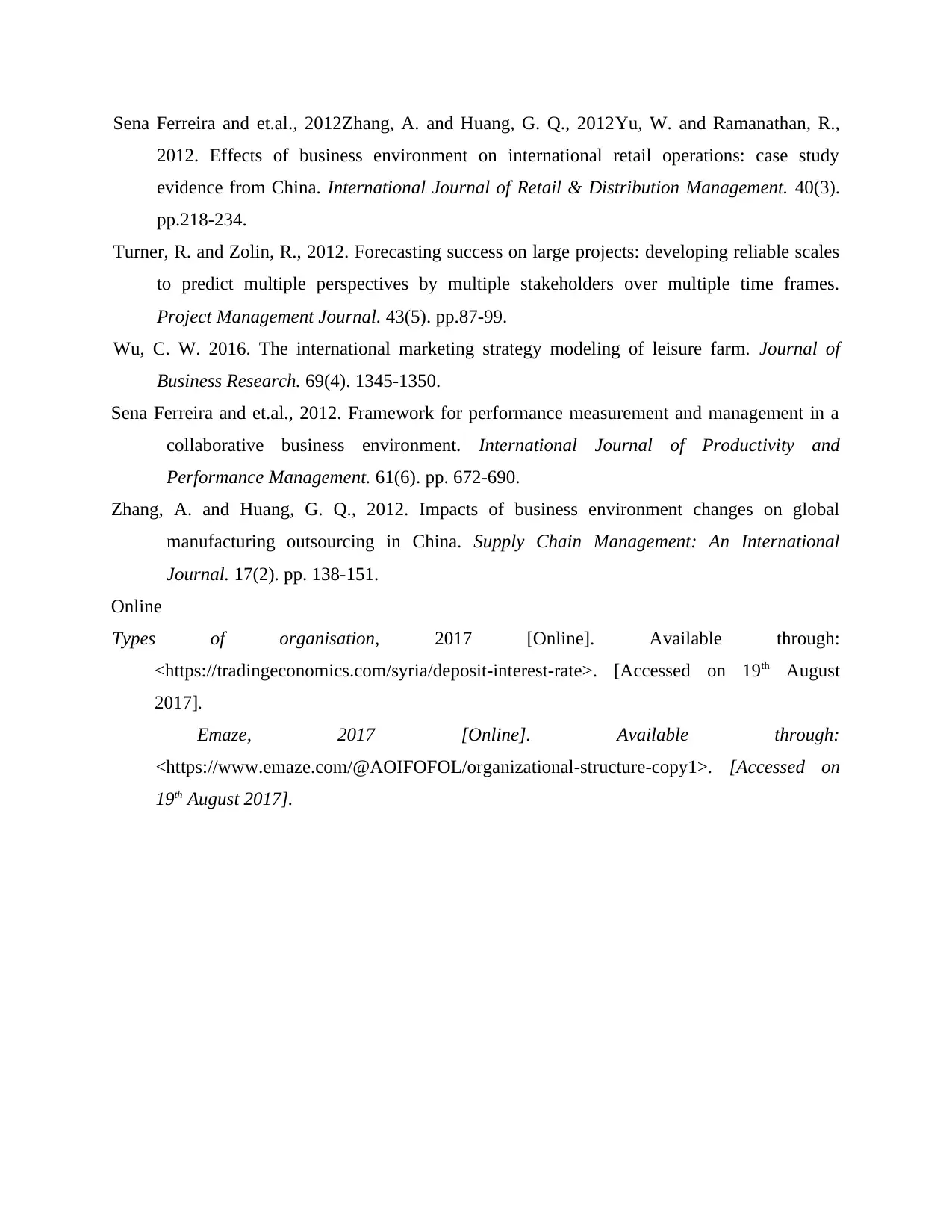
Sena Ferreira and et.al., 2012Zhang, A. and Huang, G. Q., 2012Yu, W. and Ramanathan, R.,
2012. Effects of business environment on international retail operations: case study
evidence from China. International Journal of Retail & Distribution Management. 40(3).
pp.218-234.
Turner, R. and Zolin, R., 2012. Forecasting success on large projects: developing reliable scales
to predict multiple perspectives by multiple stakeholders over multiple time frames.
Project Management Journal. 43(5). pp.87-99.
Wu, C. W. 2016. The international marketing strategy modeling of leisure farm. Journal of
Business Research. 69(4). 1345-1350.
Sena Ferreira and et.al., 2012. Framework for performance measurement and management in a
collaborative business environment. International Journal of Productivity and
Performance Management. 61(6). pp. 672-690.
Zhang, A. and Huang, G. Q., 2012. Impacts of business environment changes on global
manufacturing outsourcing in China. Supply Chain Management: An International
Journal. 17(2). pp. 138-151.
Online
Types of organisation, 2017 [Online]. Available through:
<https://tradingeconomics.com/syria/deposit-interest-rate>. [Accessed on 19th August
2017].
Emaze, 2017 [Online]. Available through:
<https://www.emaze.com/@AOIFOFOL/organizational-structure-copy1>. [Accessed on
19th August 2017].
2012. Effects of business environment on international retail operations: case study
evidence from China. International Journal of Retail & Distribution Management. 40(3).
pp.218-234.
Turner, R. and Zolin, R., 2012. Forecasting success on large projects: developing reliable scales
to predict multiple perspectives by multiple stakeholders over multiple time frames.
Project Management Journal. 43(5). pp.87-99.
Wu, C. W. 2016. The international marketing strategy modeling of leisure farm. Journal of
Business Research. 69(4). 1345-1350.
Sena Ferreira and et.al., 2012. Framework for performance measurement and management in a
collaborative business environment. International Journal of Productivity and
Performance Management. 61(6). pp. 672-690.
Zhang, A. and Huang, G. Q., 2012. Impacts of business environment changes on global
manufacturing outsourcing in China. Supply Chain Management: An International
Journal. 17(2). pp. 138-151.
Online
Types of organisation, 2017 [Online]. Available through:
<https://tradingeconomics.com/syria/deposit-interest-rate>. [Accessed on 19th August
2017].
Emaze, 2017 [Online]. Available through:
<https://www.emaze.com/@AOIFOFOL/organizational-structure-copy1>. [Accessed on
19th August 2017].
1 out of 15
Your All-in-One AI-Powered Toolkit for Academic Success.
+13062052269
info@desklib.com
Available 24*7 on WhatsApp / Email
![[object Object]](/_next/static/media/star-bottom.7253800d.svg)
Unlock your academic potential
© 2024 | Zucol Services PVT LTD | All rights reserved.





